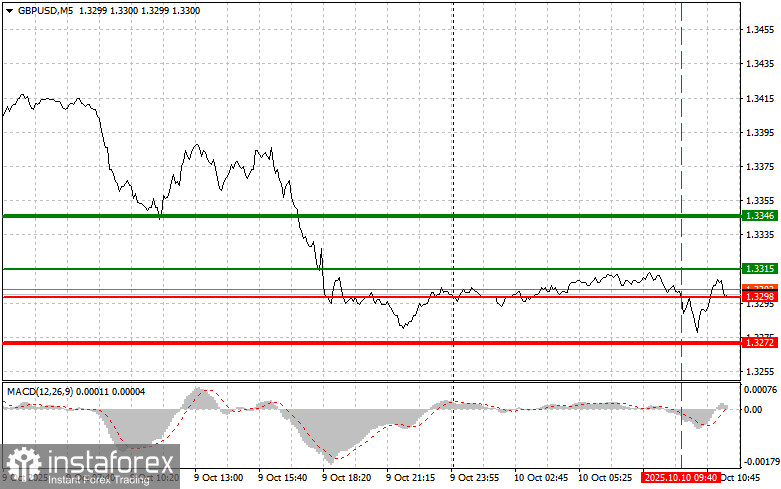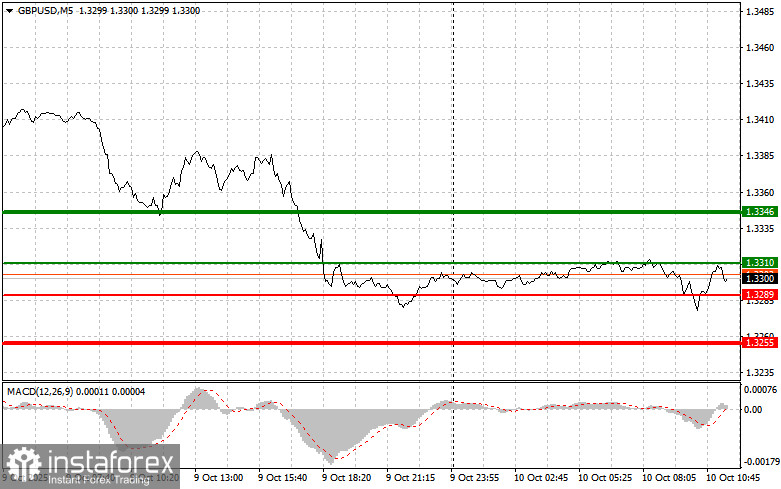Trade Analysis and Advice on the British Pound
The test of 1.3298 occurred when the MACD indicator had already moved far below the zero mark, which limited the pair's downward potential. For this reason, I did not sell the pound.
This week, investors will focus on speeches by U.S. Federal Reserve representatives Austan D. Goolsbee and Alberto Musalem. Markets will closely monitor their statements to get a sense of the regulator's future plans regarding monetary policy. Any hints of tightening or, on the contrary, readiness to ease policy could trigger sharp swings in the currency markets. Alongside these speeches, particular importance will be given to the University of Michigan's Consumer Sentiment Index. This indicator is a key gauge of consumer confidence, which directly affects consumer spending — the main driver of the U.S. economy. A rise in the index will strengthen the dollar. Equally important will be the inflation expectations data, also published by the University of Michigan. Higher inflation expectations could act as a catalyst for fresh dollar buying, as rising expectations may push the Fed toward a more aggressive interest rate policy to contain price growth.
As for intraday strategy, I will focus mainly on Scenarios #1 and #2.

Buy Signal
Scenario #1: I plan to buy the pound today at the entry point around 1.3310 (green line on the chart), targeting growth toward 1.3346 (thicker green line on the chart). Around 1.3346, I will exit purchases and open sales in the opposite direction (expecting a move of 30–35 points in the opposite direction from that level). Strong growth in the pound today will only be realistic if Fed representatives deliver dovish remarks.Important! Before buying, make sure the MACD indicator is above zero and just beginning its rise from that level.
Scenario #2: I also plan to buy the pound today if there are two consecutive tests of the 1.3289 level when the MACD indicator is in oversold territory. This will limit the pair's downward potential and trigger a reversal upward. Growth toward the opposite levels of 1.3310 and 1.3346 can then be expected.
Sell Signal
Scenario #1: I plan to sell the pound today after a breakout of the 1.3289 level (red line on the chart), which will lead to a quick decline in the pair. The key target for sellers will be 1.3255, where I will exit sales and immediately open purchases in the opposite direction (expecting a 20–25 point move in the opposite direction from that level). The pound could collapse sharply in the second half of the day.Important! Before selling, make sure the MACD indicator is below zero and just beginning its decline from that level.
Scenario #2: I also plan to sell the pound today if there are two consecutive tests of the 1.3310 level when the MACD indicator is in overbought territory. This will limit the pair's upward potential and lead to a reversal downward. A decline toward the opposite levels of 1.3289 and 1.3255 can then be expected.

What's on the Chart:
- Thin green line – entry price at which the trading instrument can be bought;
- Thick green line – projected price where Take Profit can be set or profit can be manually fixed, since further growth above this level is unlikely;
- Thin red line – entry price at which the trading instrument can be sold;
- Thick red line – projected price where Take Profit can be set or profit can be manually fixed, since further decline below this level is unlikely;
- MACD indicator – when entering the market, it is important to be guided by overbought and oversold zones.
Important for beginners: On the Forex market, it is crucial to be very cautious when deciding on entries. Before major fundamental reports are released, it is best to stay out of the market to avoid sharp price swings. If you choose to trade during news releases, always place stop-loss orders to minimize losses. Without stop-losses, you can quickly lose your entire deposit, especially if you ignore money management and trade with large volumes.
And remember: for successful trading, you need to have a clear trading plan, like the one outlined above. Spontaneous decision-making based on the current market situation is an inherently losing strategy for an intraday trader.





















